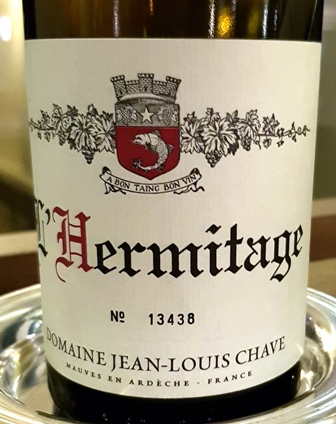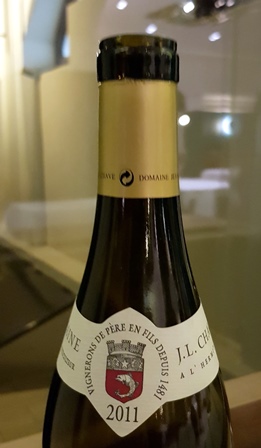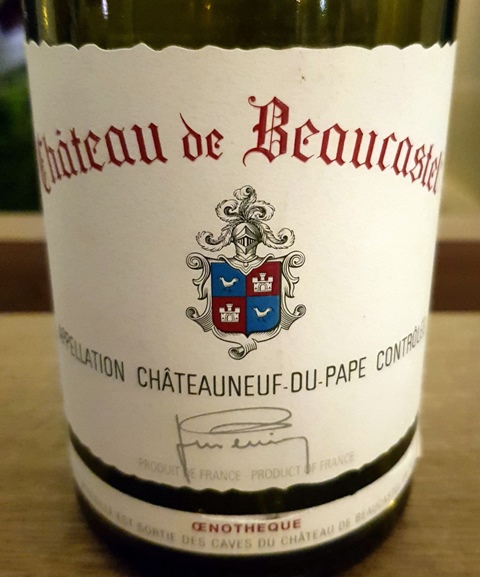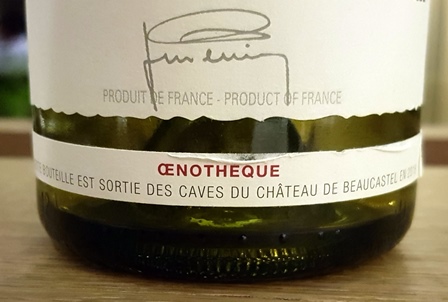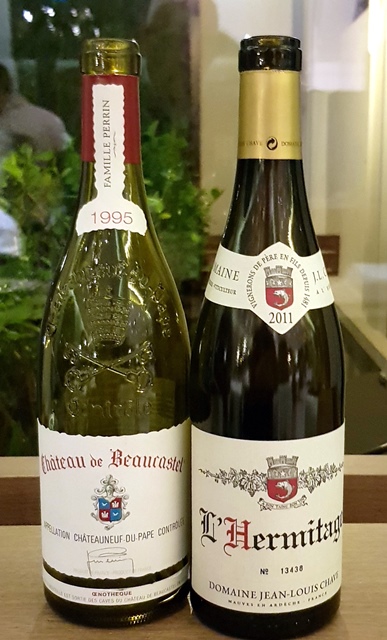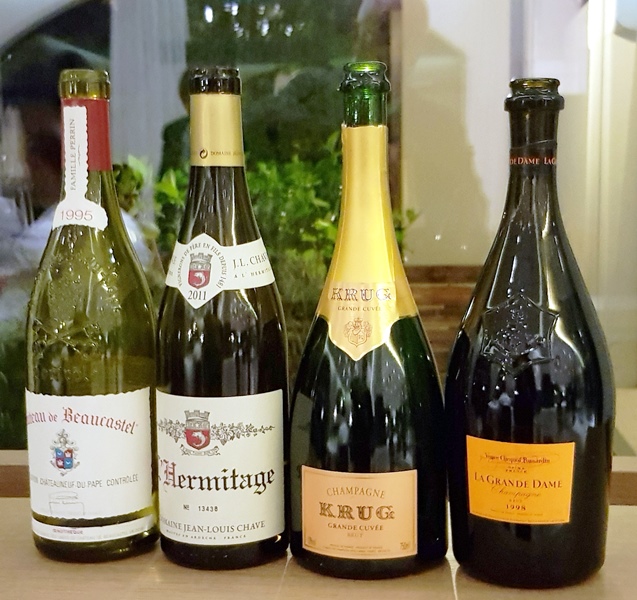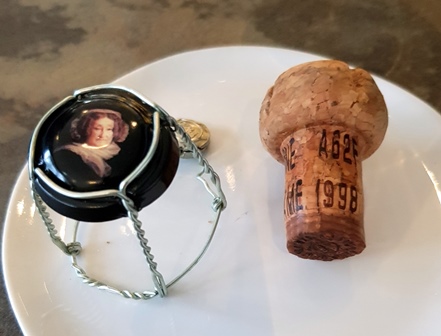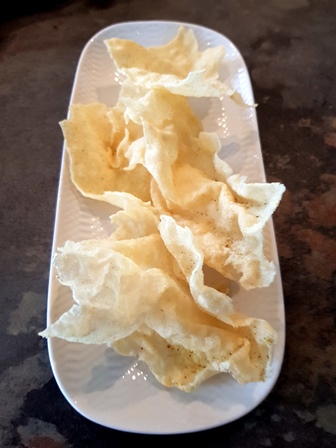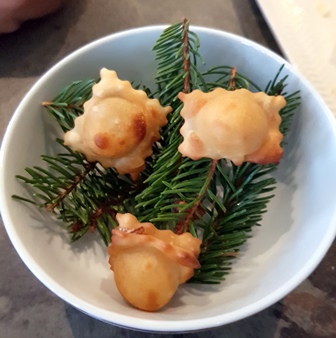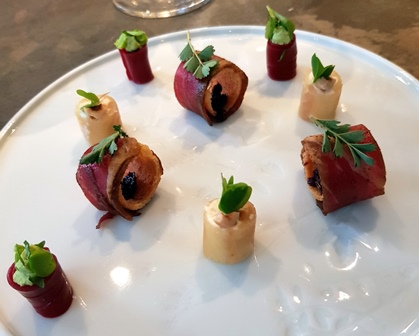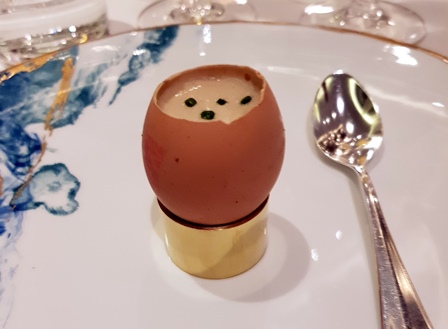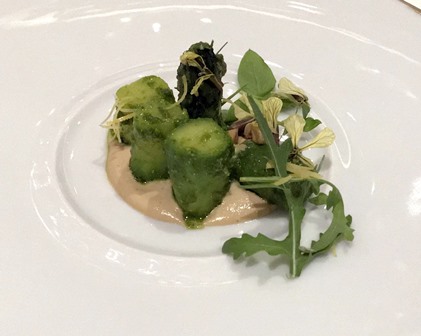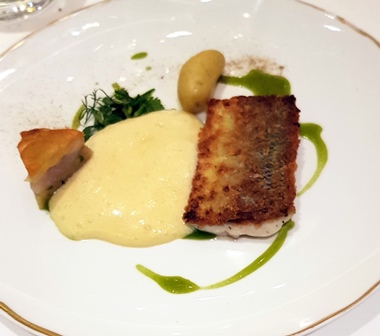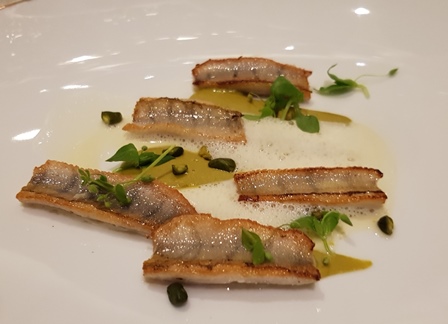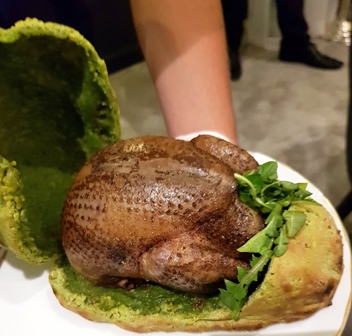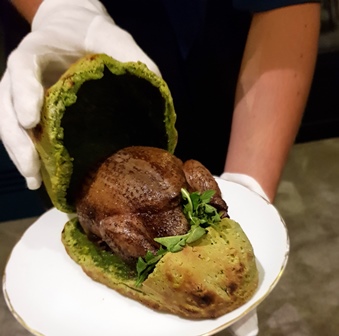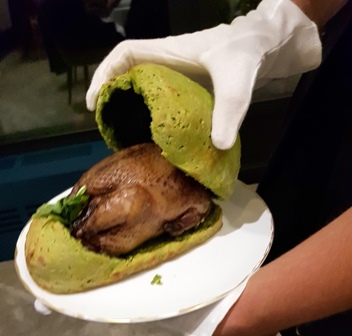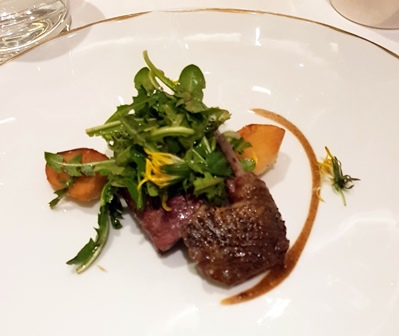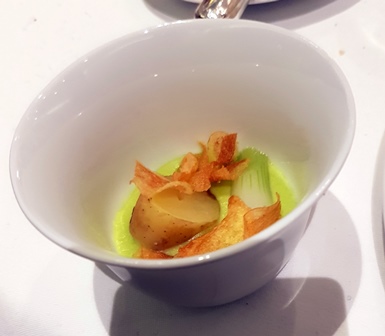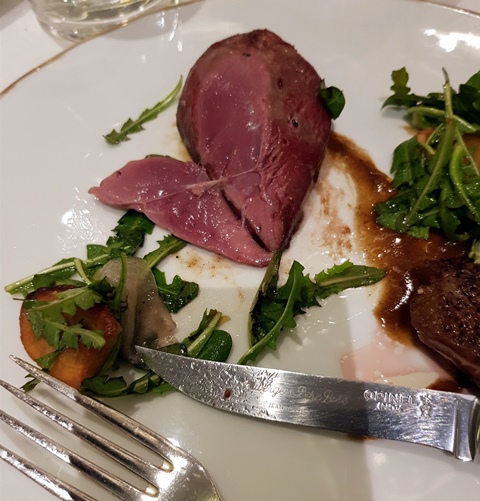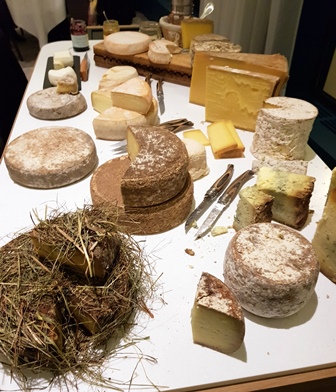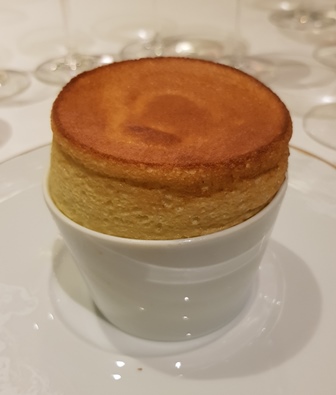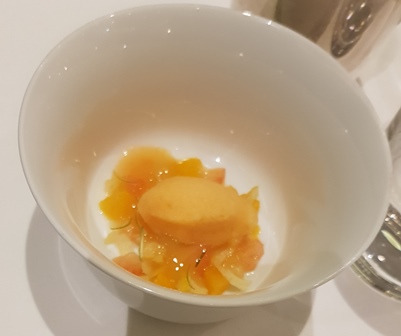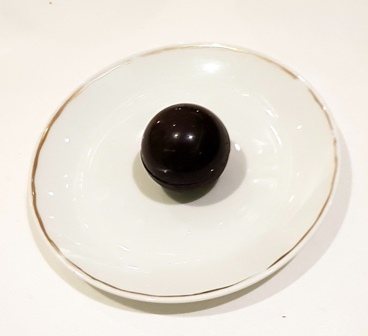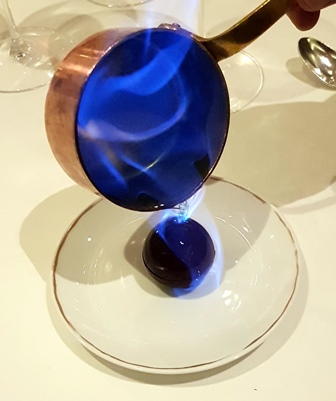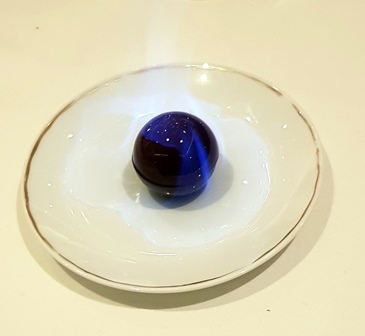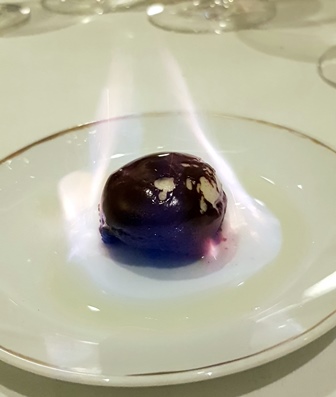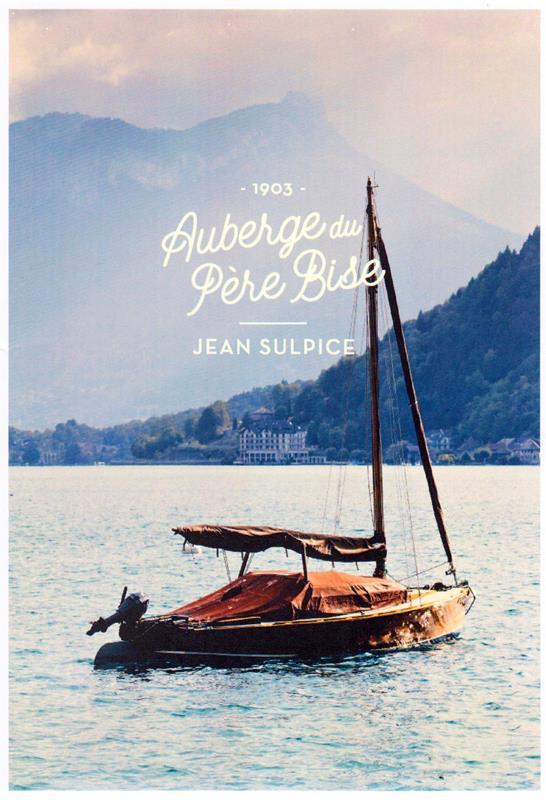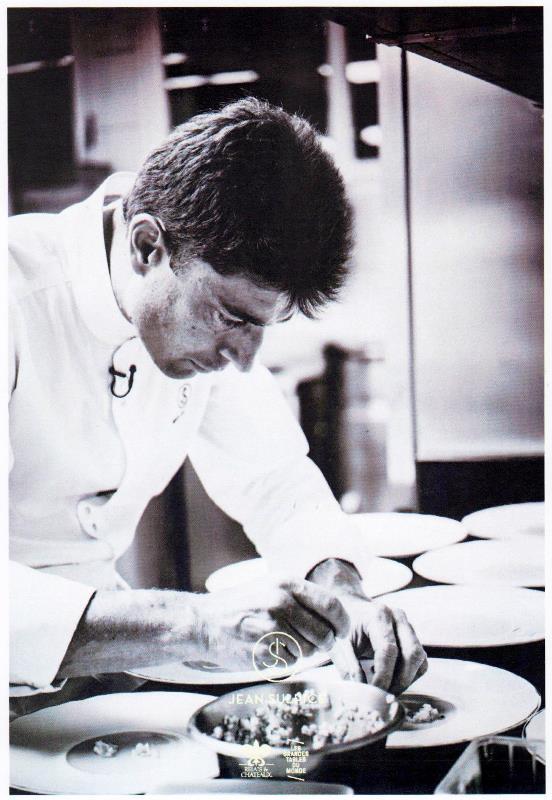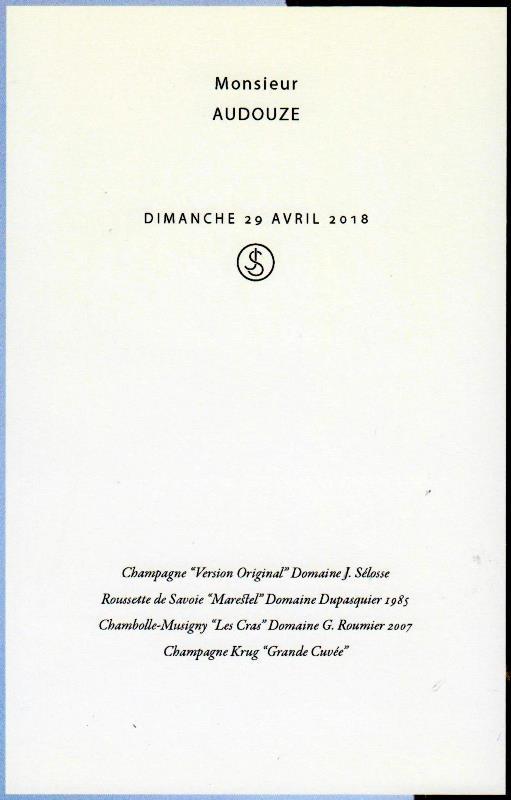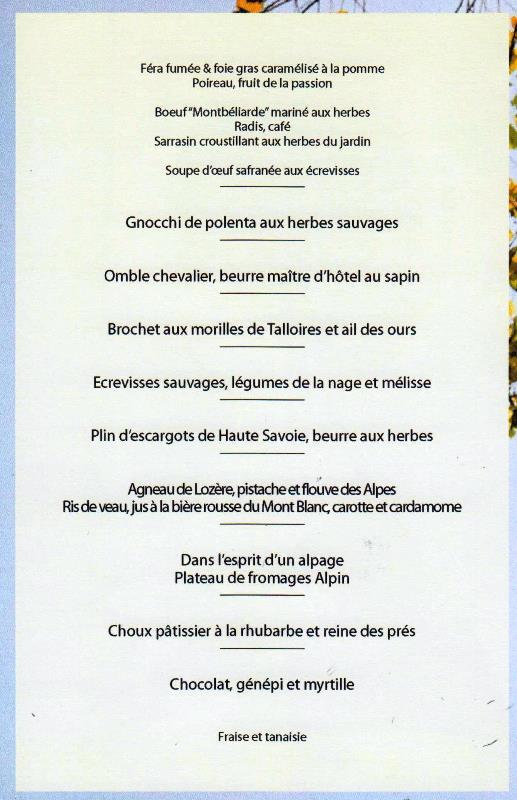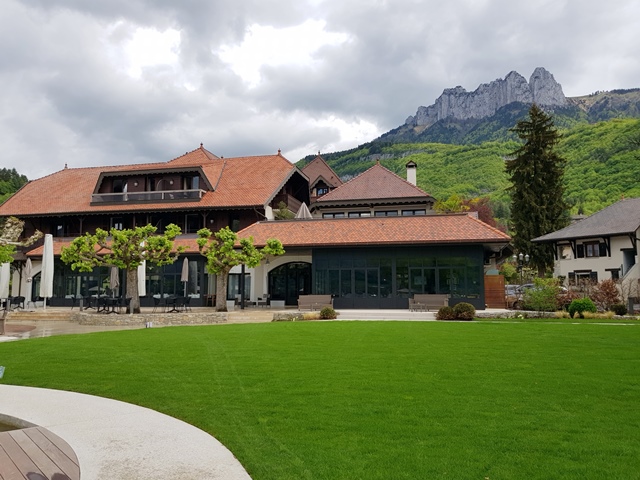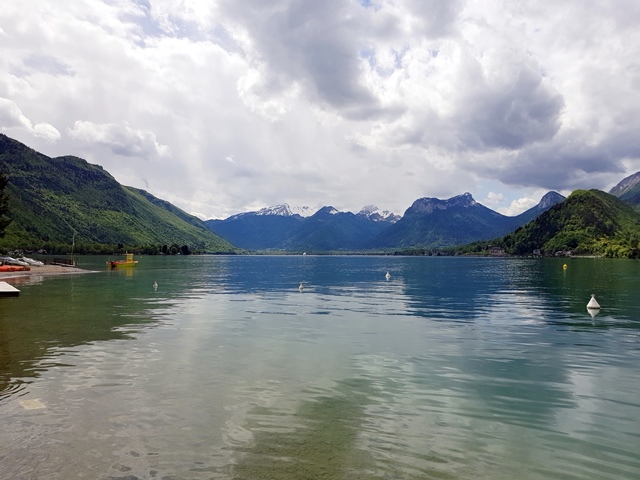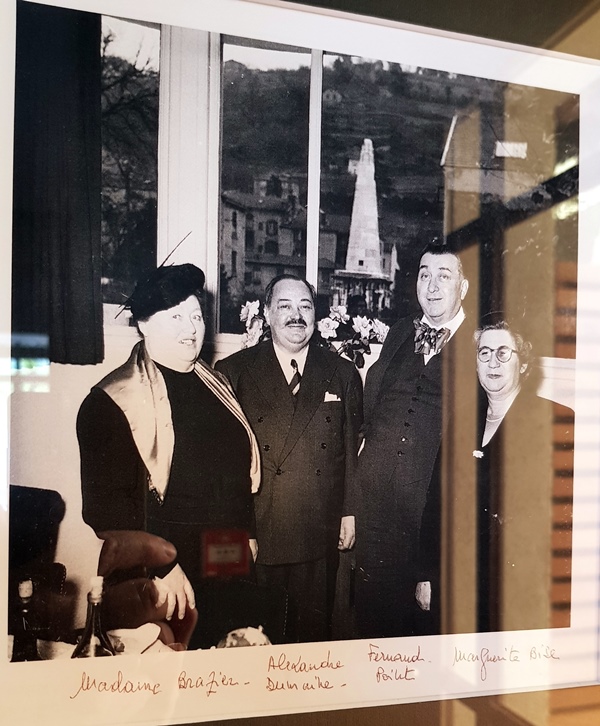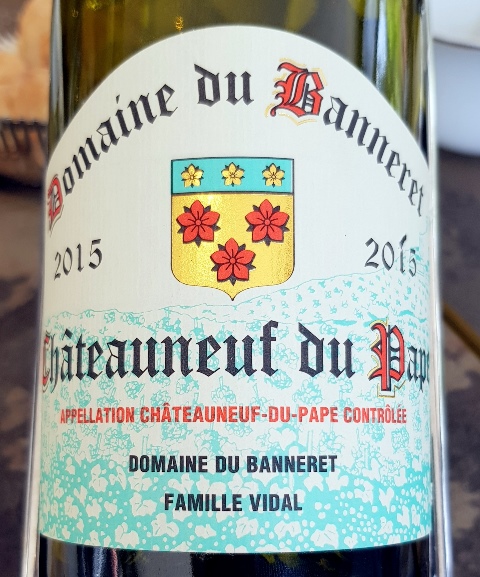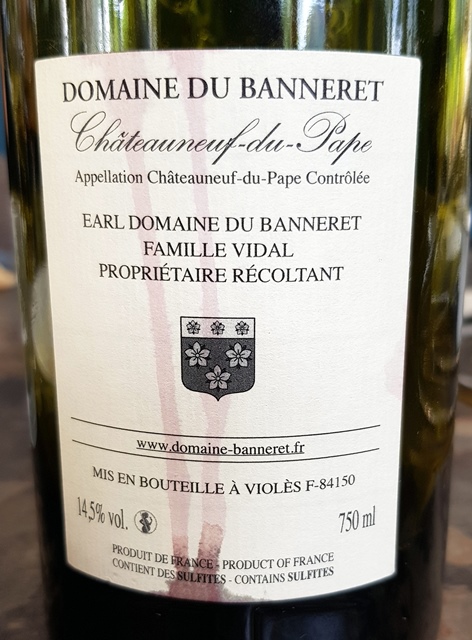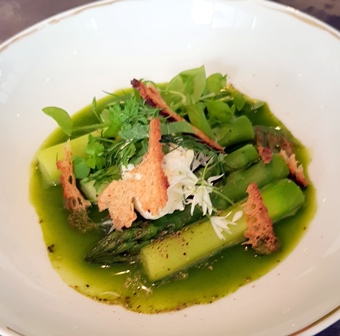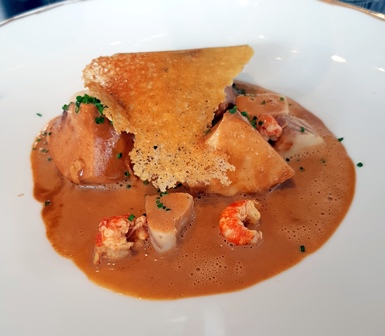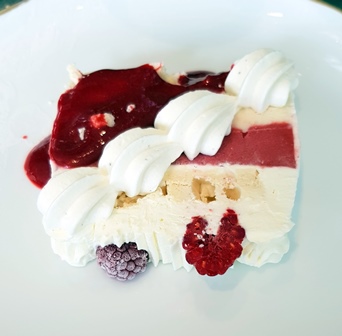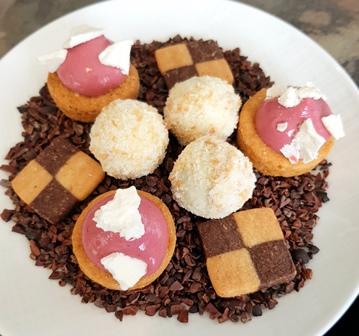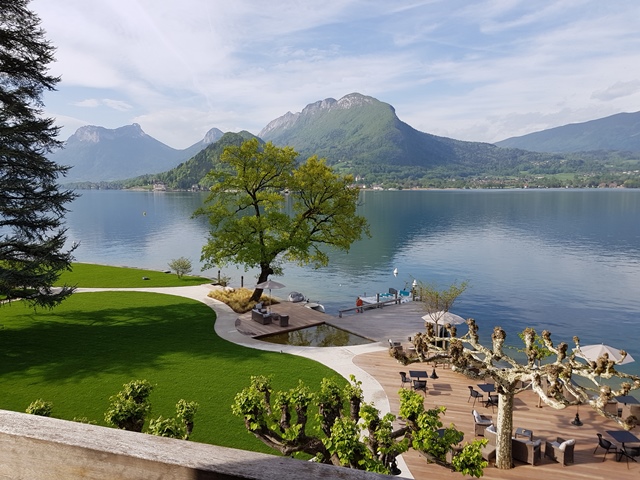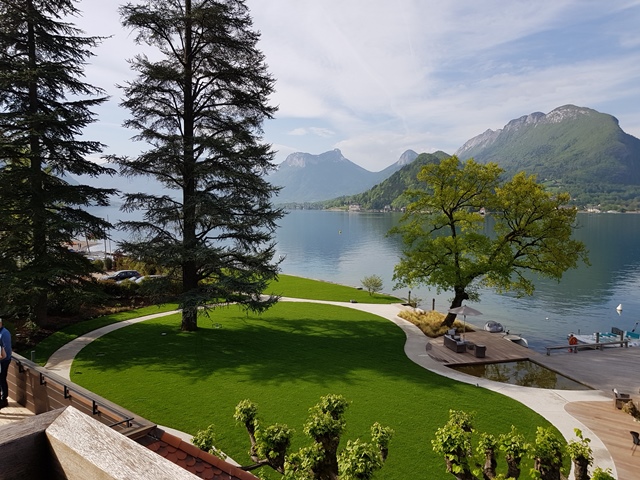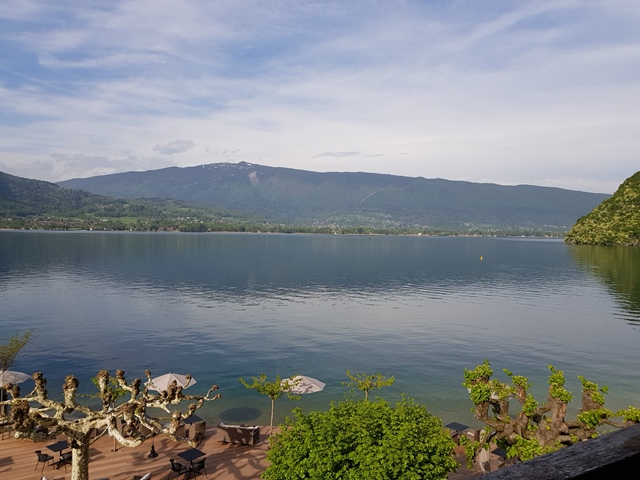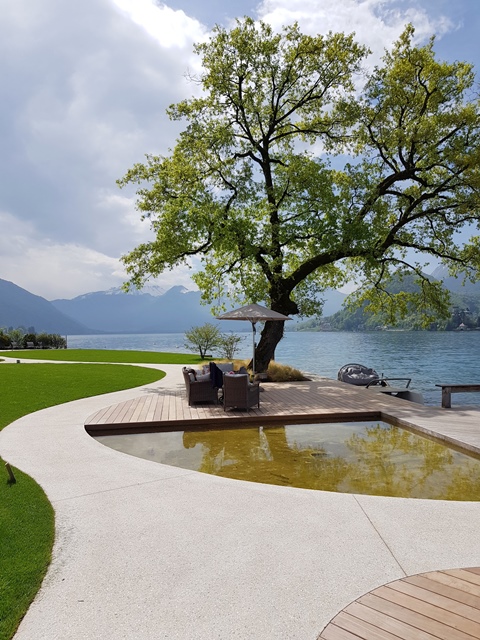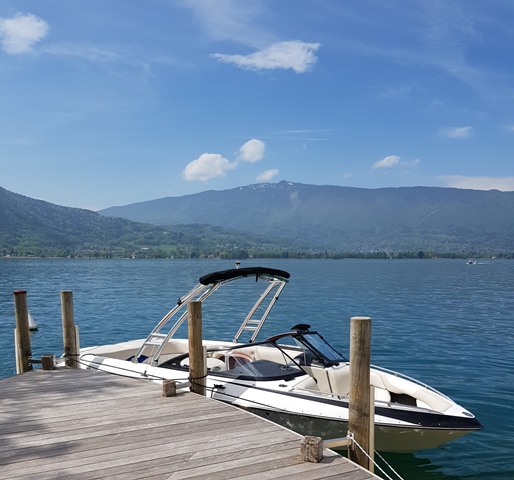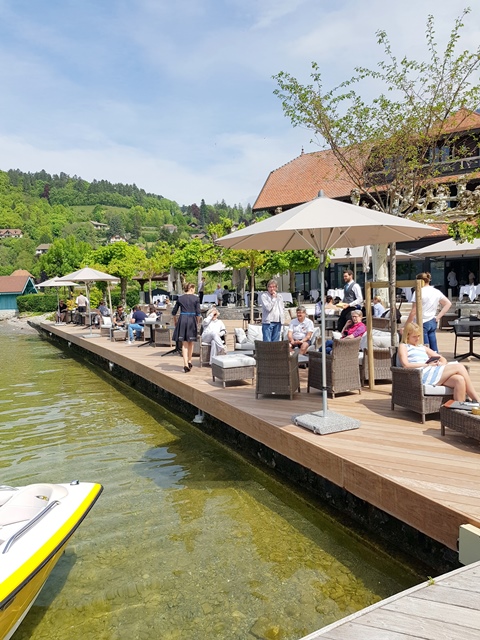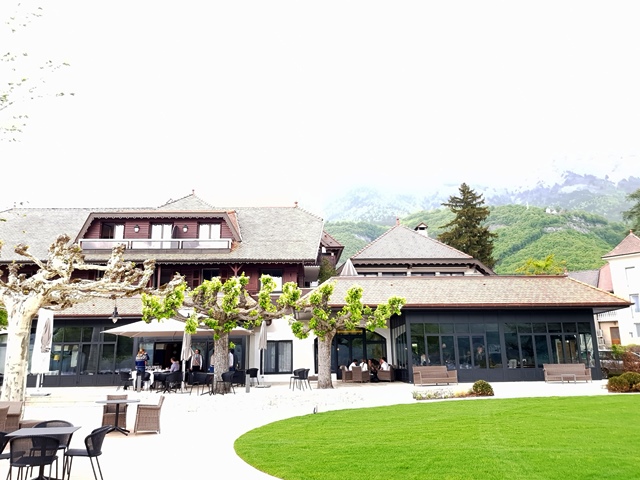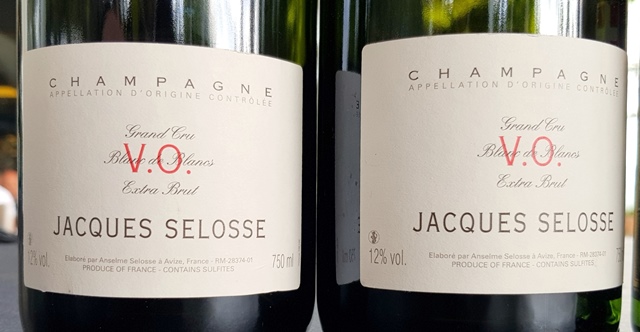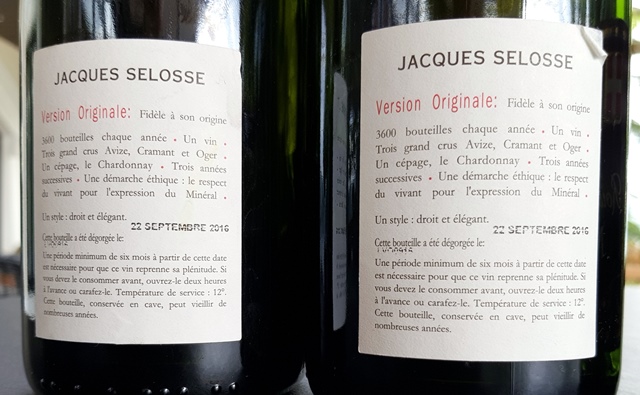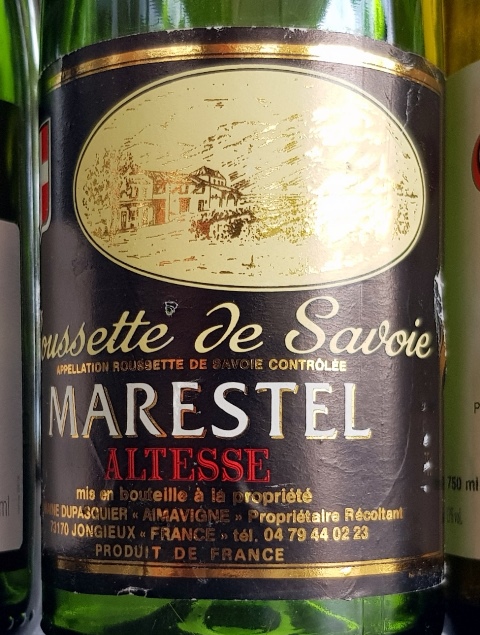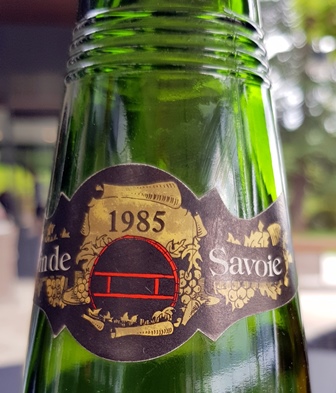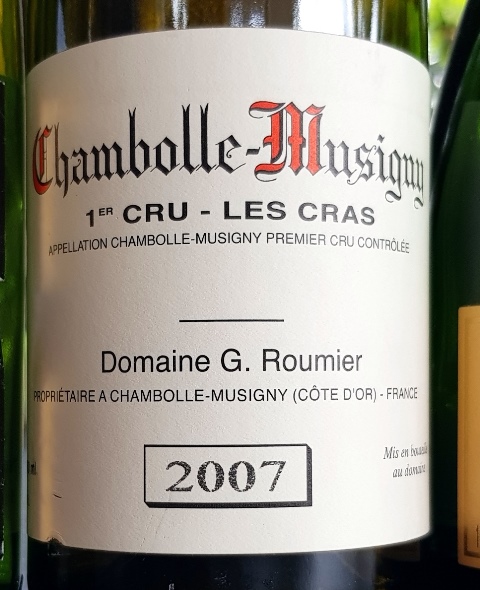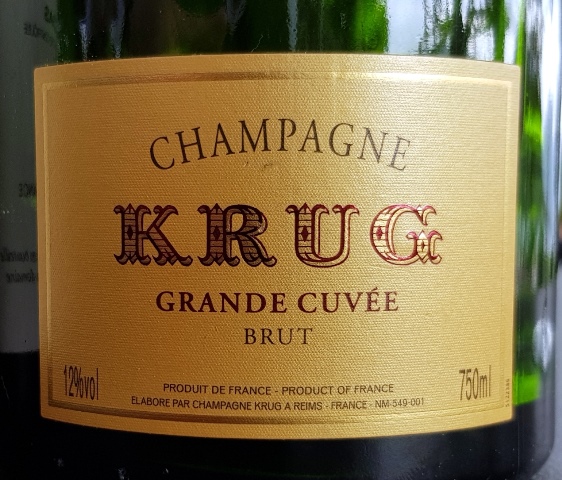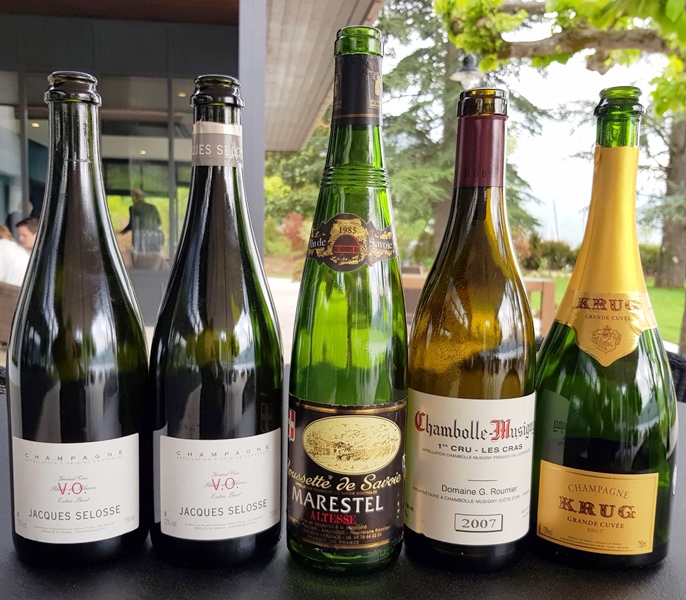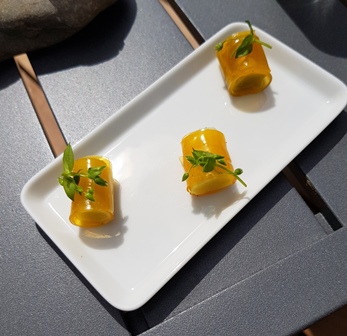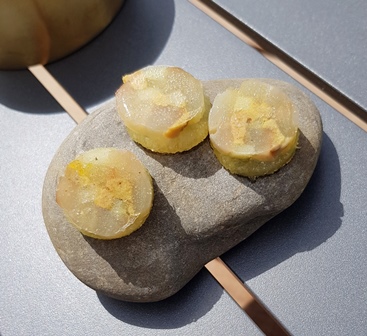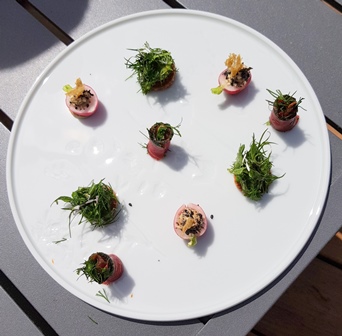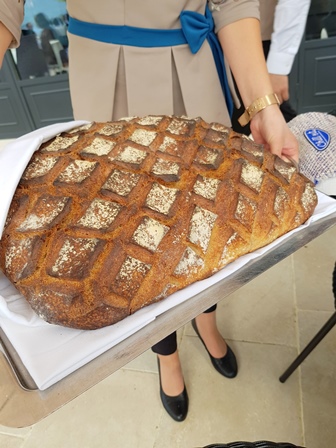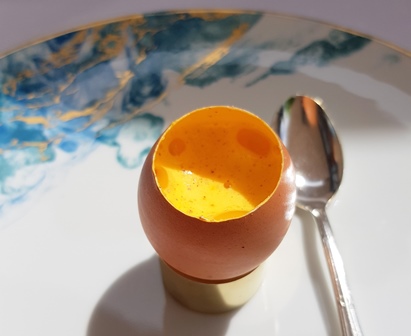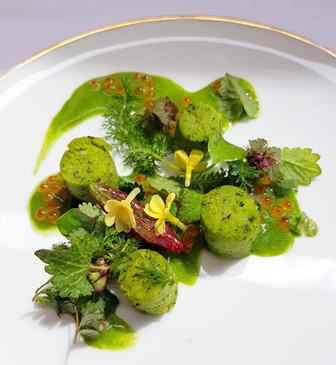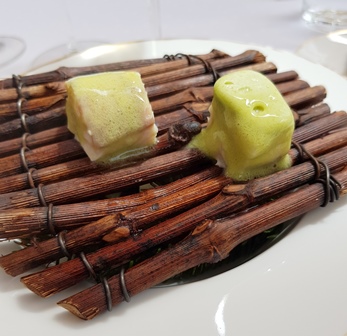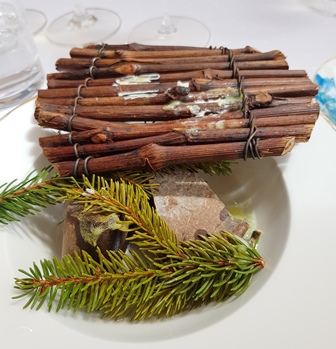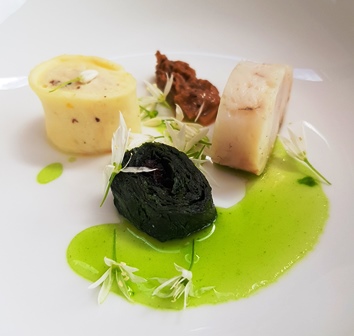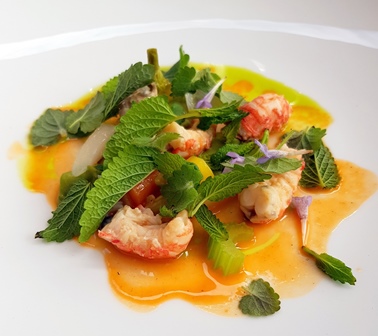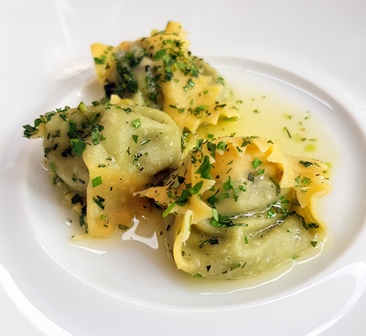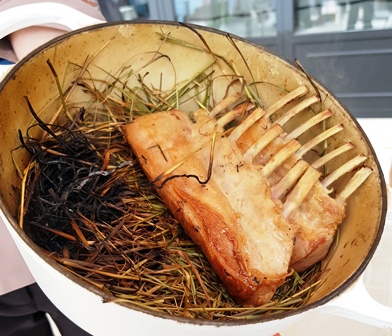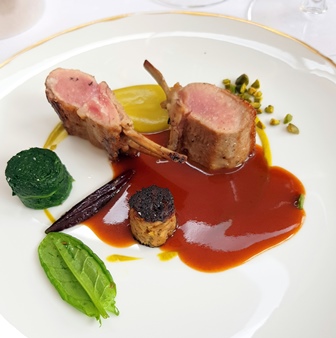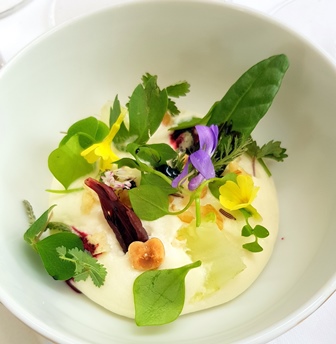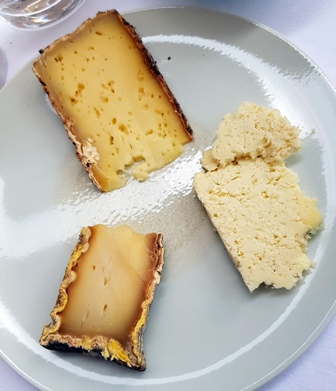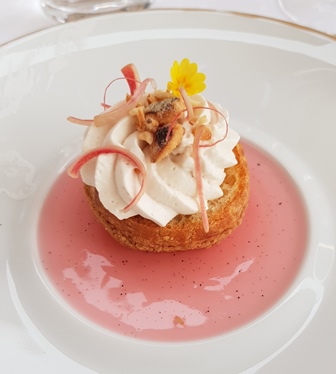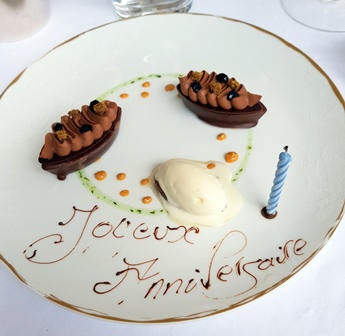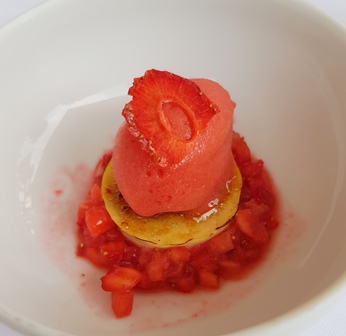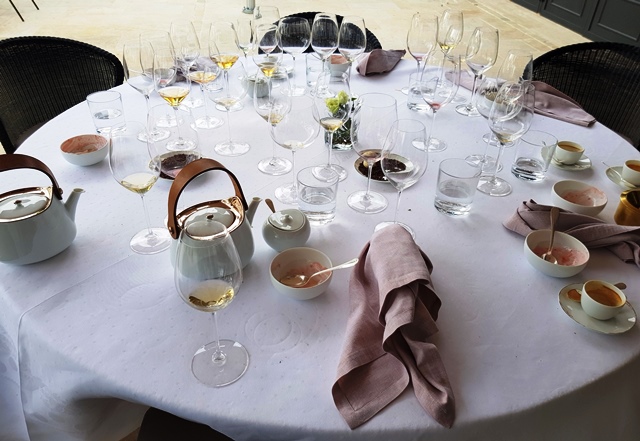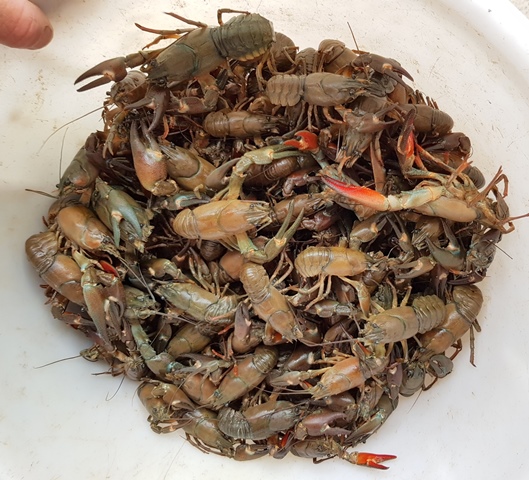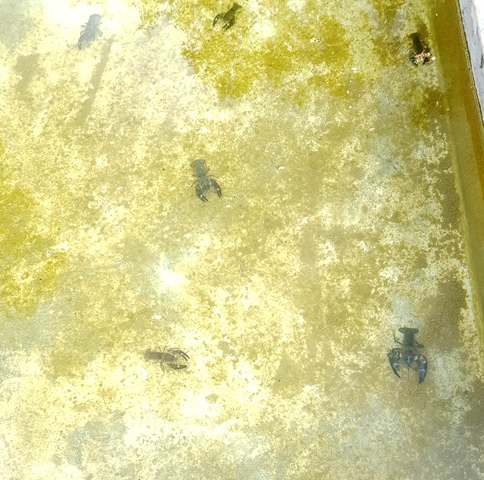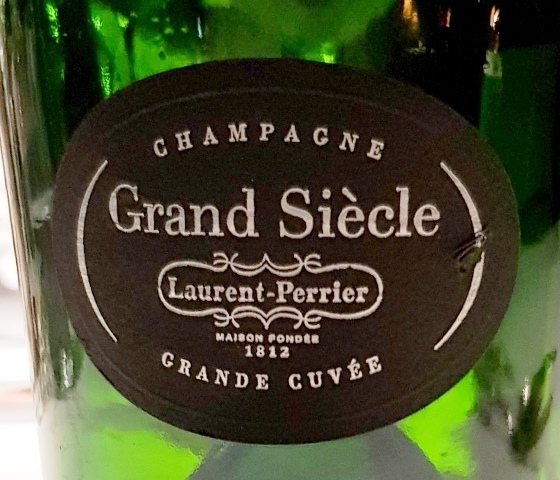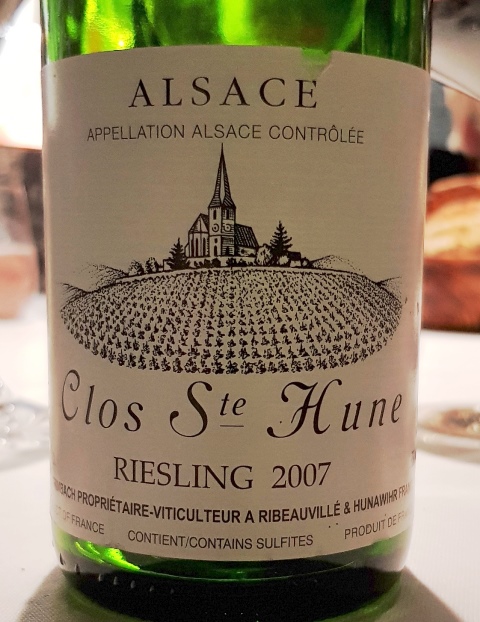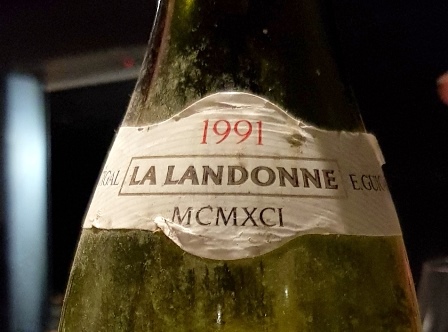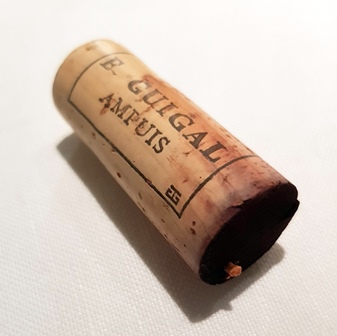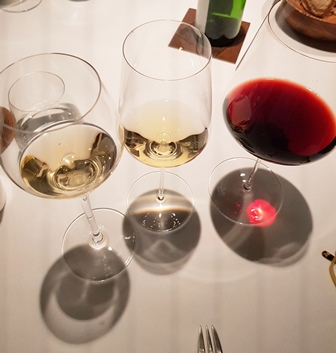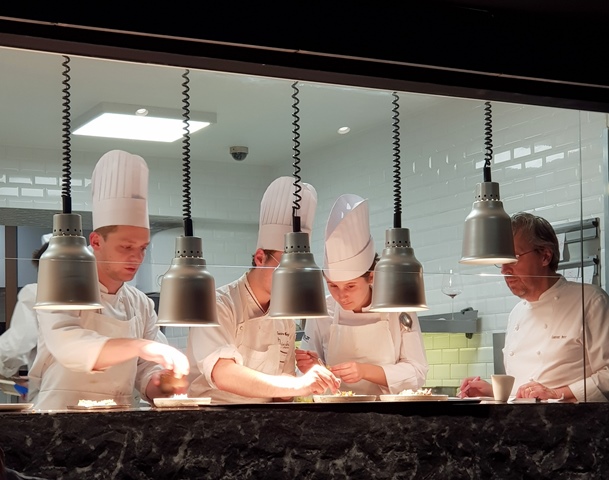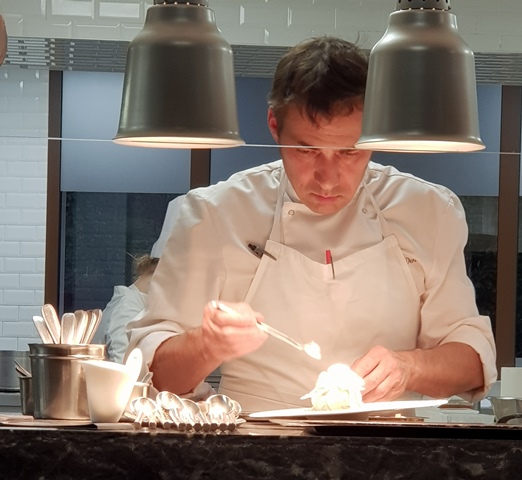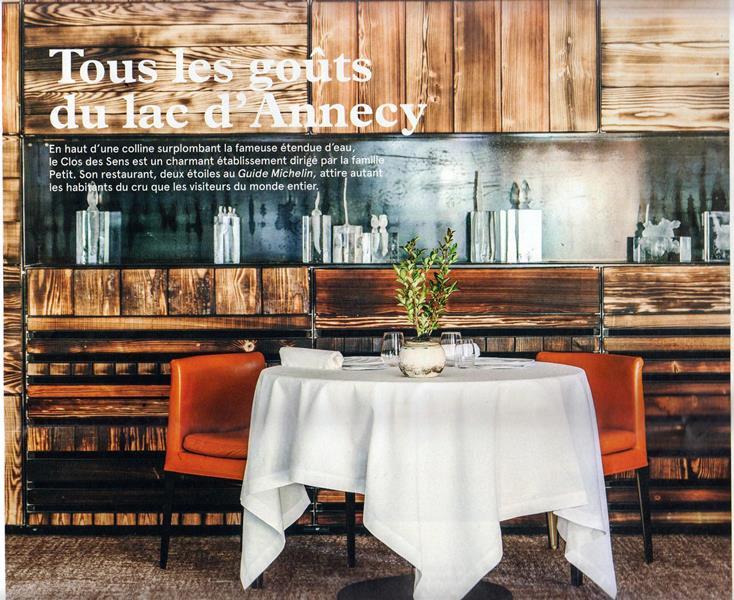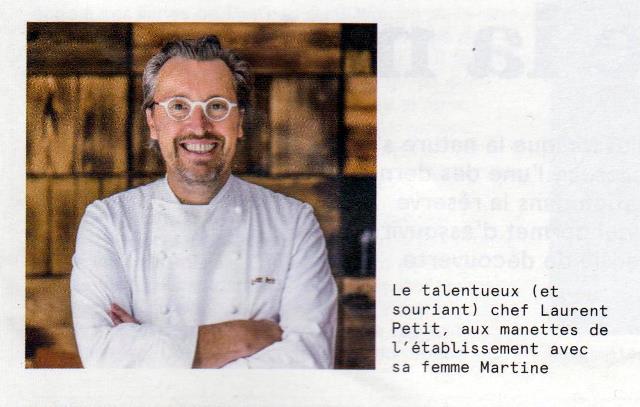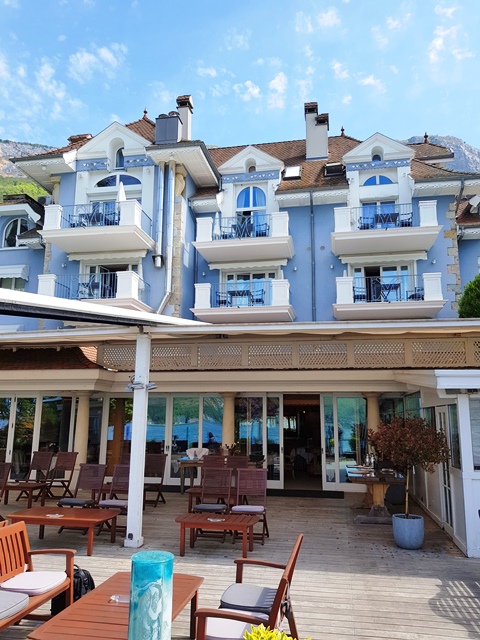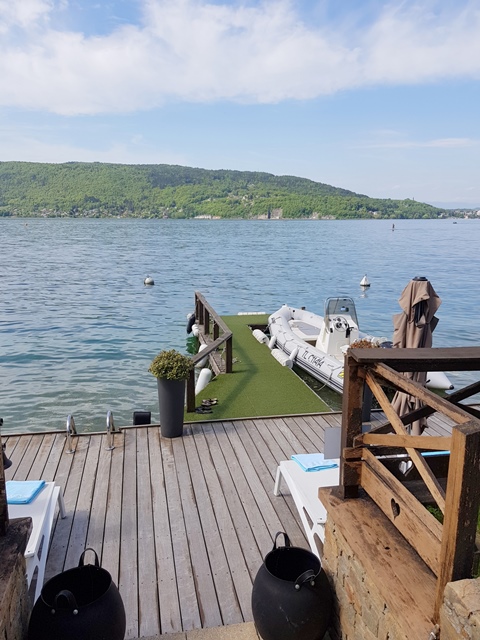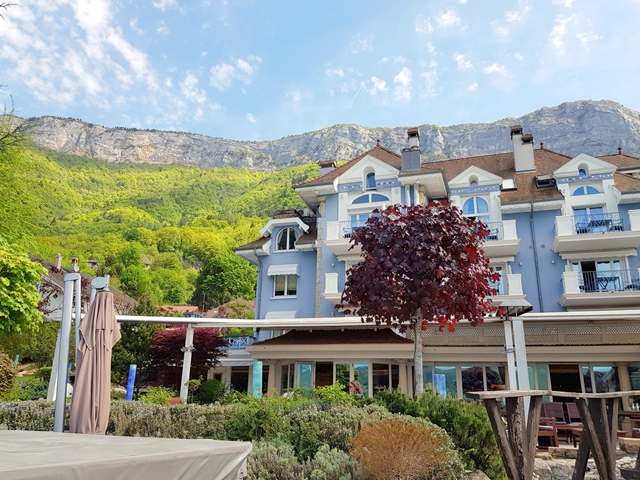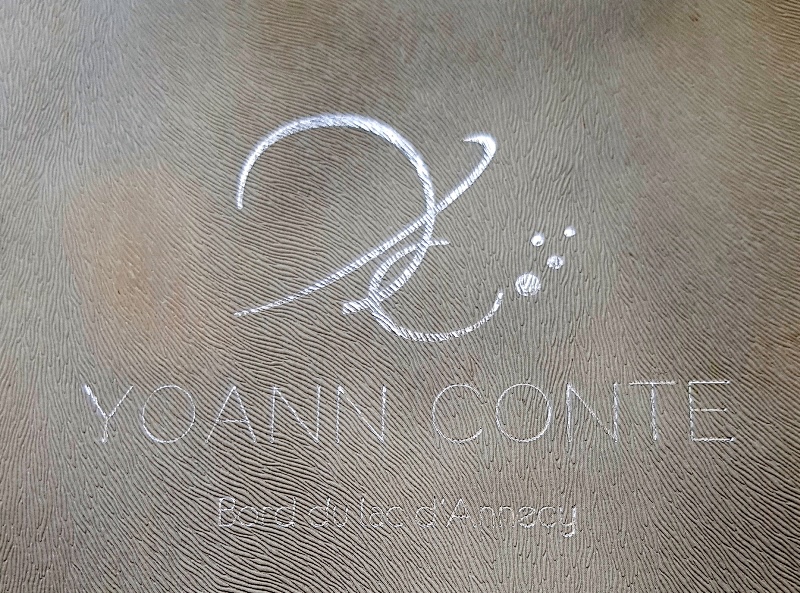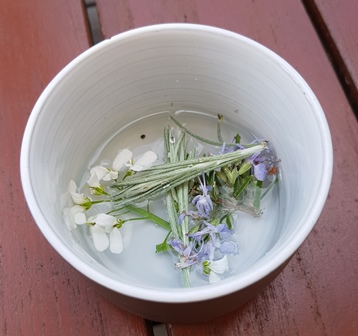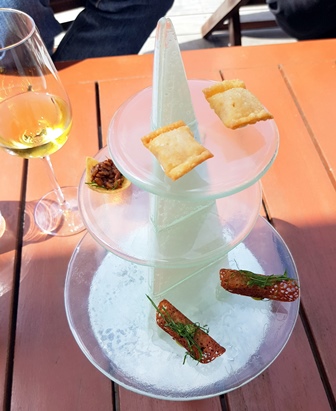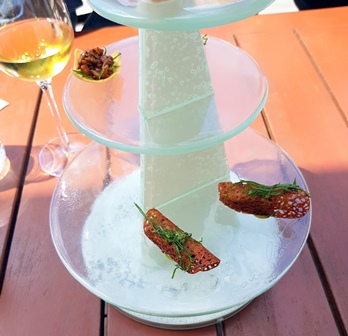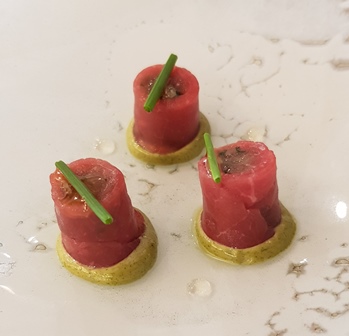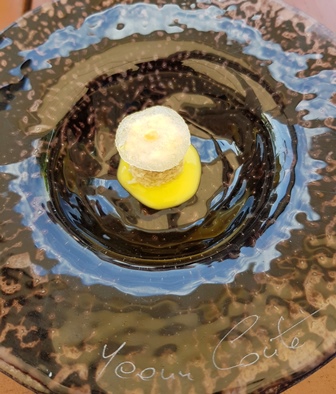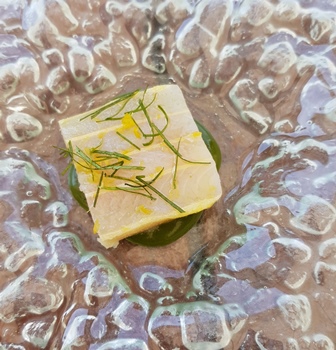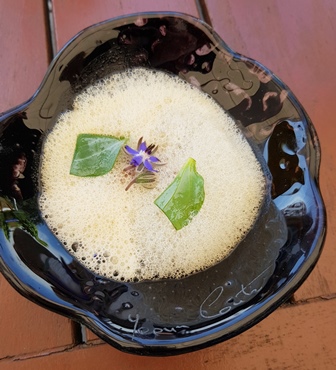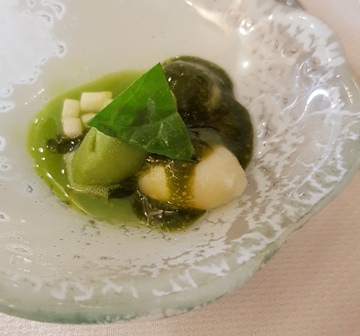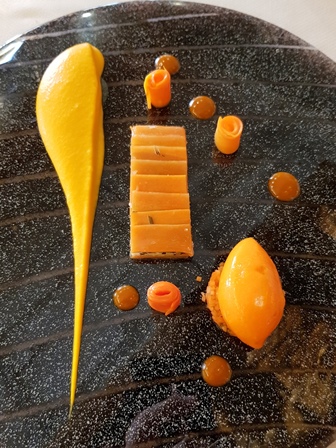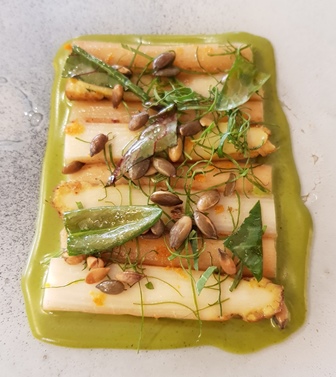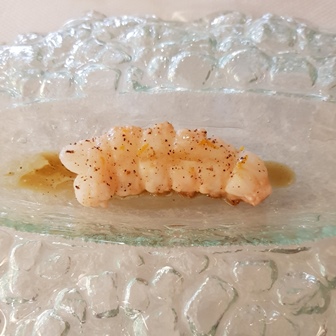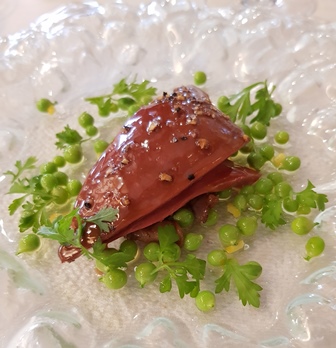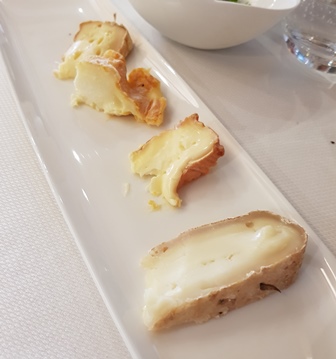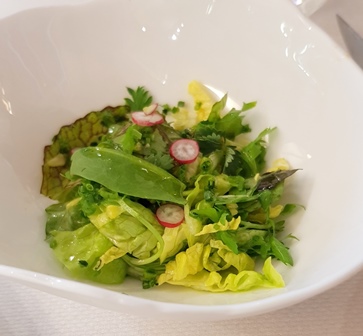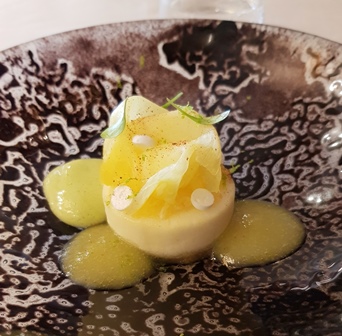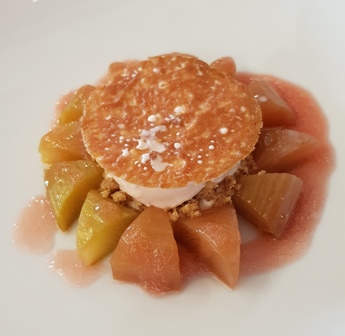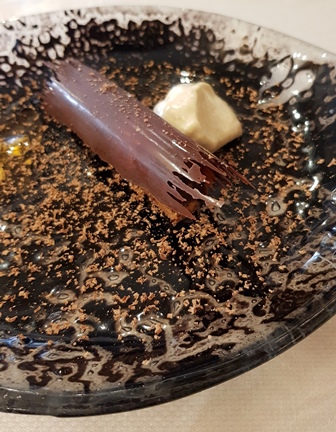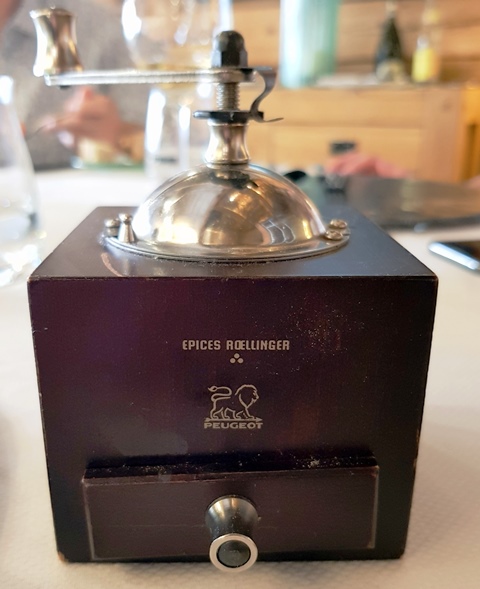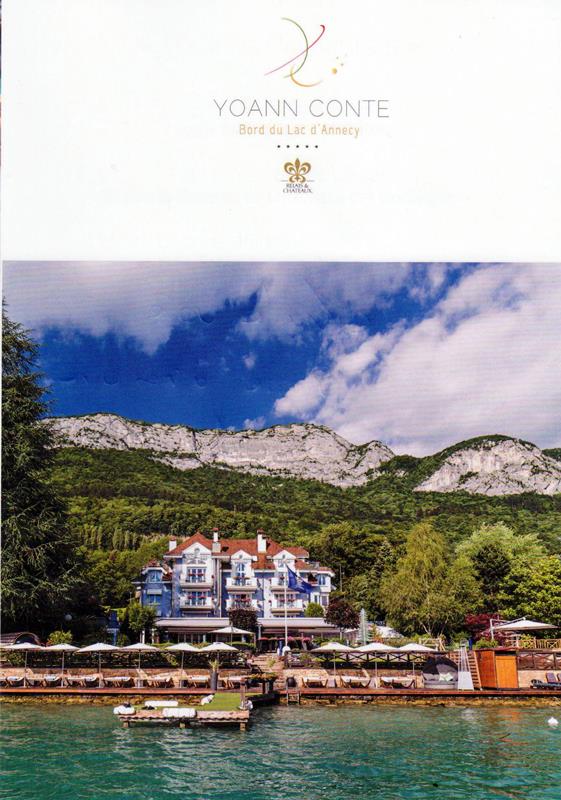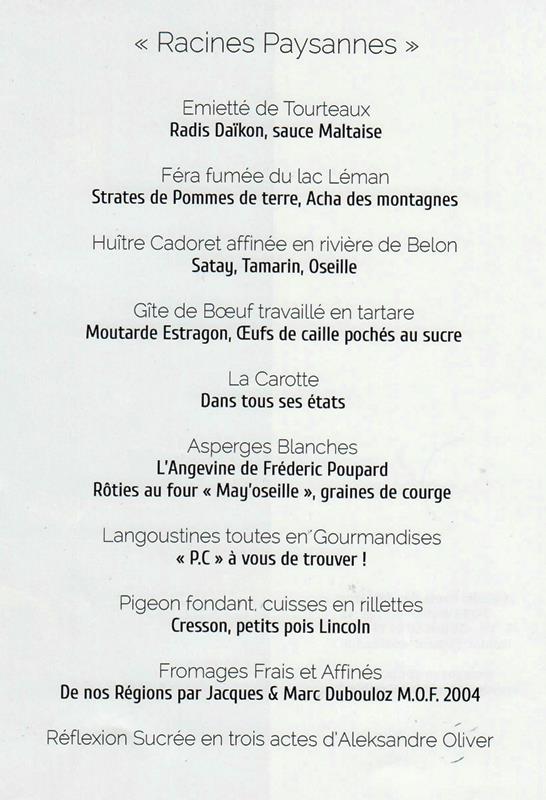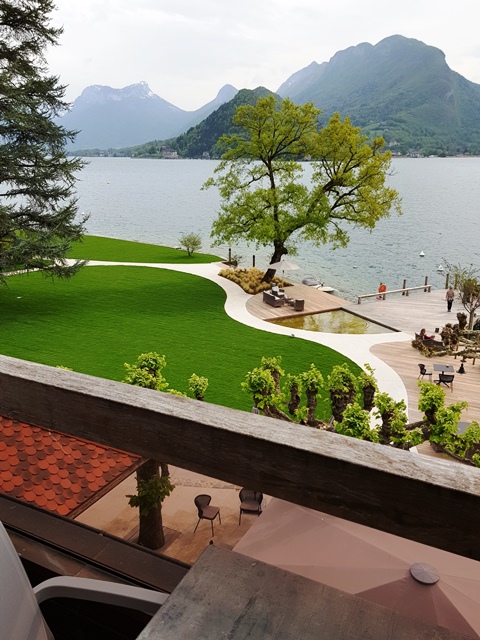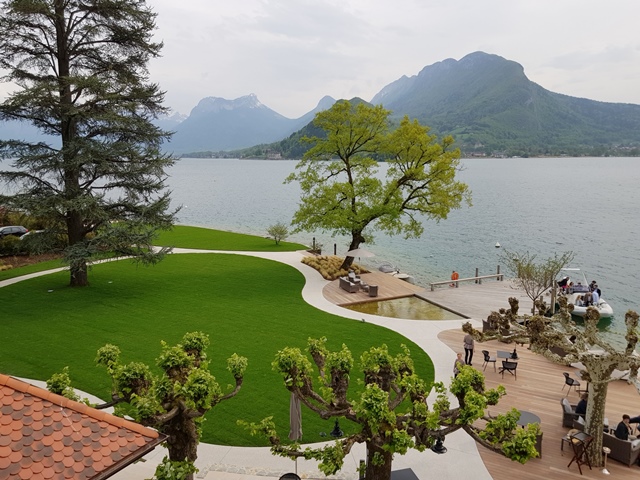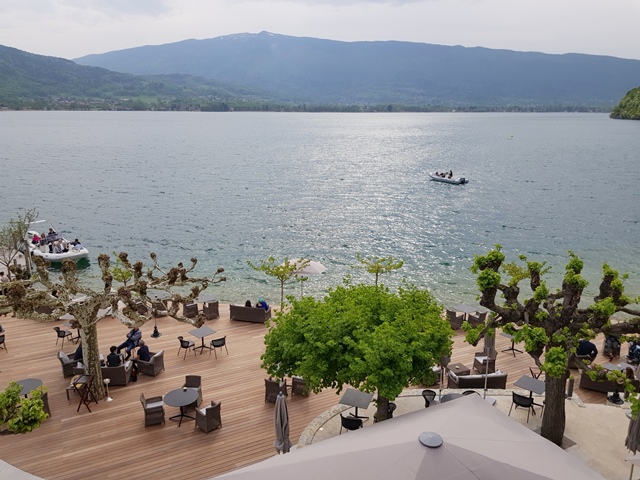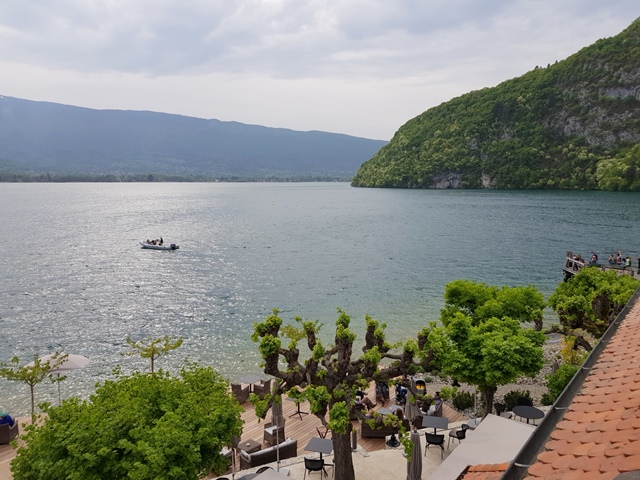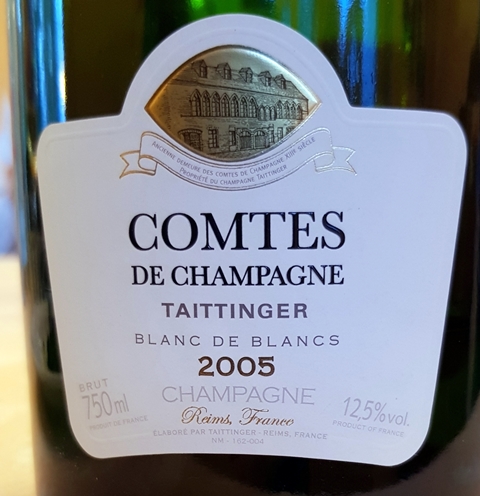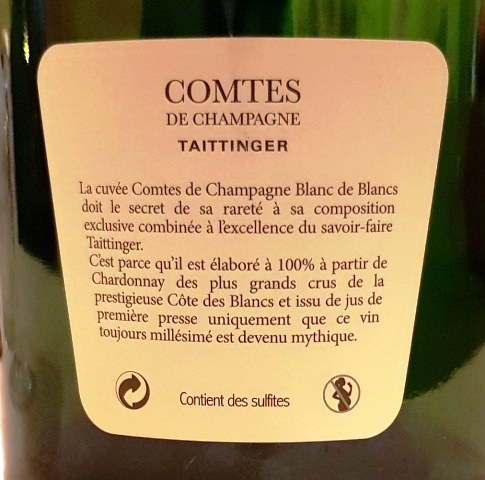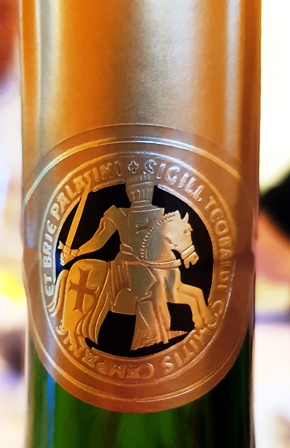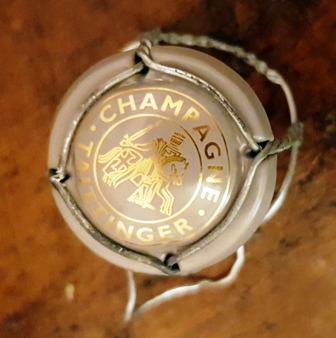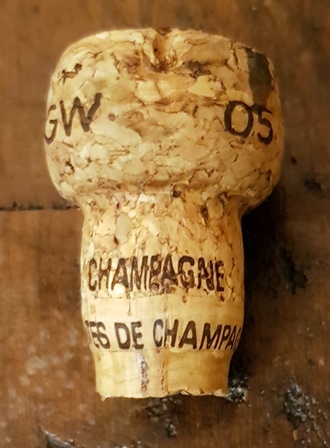Un dimanche à 19 heures se tient au restaurant Pages le dîner de la « Wagyu Mafia ». D’après ce que j’ai compris la Wagyu Mafia est un groupe de restaurants qui sont spécialisés dans la viande de Kobe de très haute qualité. Pour faire connaître leurs produits, ils font chaque année un tour du monde. L’an dernier le tour du monde avait commencé au restaurant Pages et cette année leur 16ème tour du monde se finit en cet endroit.
Etant en avance je vois dans la cuisine s’affairer les deux équipes, celle du restaurant Pages et celle de la Wagyu Mafia dirigée par Hisato Hamada, le patron de ce groupe. A un moment donné tout s’arrête et le programme du dîner ayant été inscrit sur un tableau, le chef Ryuji Teshima dit Teshi et Hisato Hamada commentent et donnent les instructions de service et de finition des plats.
On offre à chacun des participants du dîner une coupe de Champagne Dom Pérignon 2009. J’aime beaucoup ce champagne qui est dans la droite ligne de ce que Dom Pérignon doit être, noble, complexe, accueillant et joyeux. A ma table il y aura l’ami avec lequel j’avais déjeuné ici il y a cinq jours et mes deux filles que j’ai invitées car le restaurant m’avait signalé que les réservations n’étaient pas complètes. J’ai fait plaisir au restaurant tout en me faisant le plaisir d’avoir mes filles près de moi.
J’ouvre les deux vins que mon ami a apportés ainsi que le vin et le champagne que j’ai apportés. Nous passons à table et voici le menu : Beef Jerky, champion Kobe Beef 2017, deux semaines de maturation / « Katsu-Sand », sandwich au bœuf Tajima de 11 ans d’âge et 40 jours de maturation, consommé de bœuf aux morilles / « Kama » de daurade royale, fines herbes / Gyoza de Wagyu / homard, tapioca, caviar impérial de Sologne / turbot mariné au Shio Koji, ventrèche de noir de Bigorre / glace aux asperges blanches de Noirmoutier, à la vanille / Wagyu-gnese / Nigiri : Uni de Hokkaido, caviar Karuga / Sukiyaki de wagyu / Keema curry au bœuf de Kobe / tarte au citron, gâteau au chocolat.
Mon ami a commandé un Champagne Jacques Selosse lieu-dit Les Carelles du Mesnil-sur-Oger dont je n’ai pas noté la date de dégorgement. Ce champagne est beaucoup plus accessible que le Champagne Selosse lieu-dit la Côte Faron à Ay que nous avons bu ensemble lors de notre récent déjeuner, champagne extra-brut sans concession. Celui-ci, même extra-brut, est plus flexible tout en ayant aussi une forte personnalité. Sur le bœuf presque séché en une fine lamelle, le champagne est tout étroit et vertical, alors que sur le délicieux tartare de veau, grâce aux coques et à la poutargue, le champagne prend une belle largeur et devient convivial.
Je fais servir le champagne que j’ai apporté, un Champagne Krug 1989. Ce champagne est d’une noblesse rare. Il brille au firmament des champagnes et il est nettement meilleur que le souvenir très positif que j’en avais. Tant mieux. On a du mal à imaginer qu’un champagne si jeune et vif ait 29 ans. Ce qui est intéressant, c’est que les trois champagnes, tous différents, peuvent trouver leur zone d’excellence. Le plus gastronomique est le Krug, mais chacun a sa part de succès.
Lorsque Hisato Hamada se présente et présente le sandwich au bœuf de 11 ans, je n’aime pas trop qu’il parle d’argent en disant que c’est le sandwich le plus cher au monde. Le bœuf est absolument délicieux mais comme on nous demande de manger le sandwich en le tenant dans sa main, sans se servir de couverts, je le regrette, car on le mange presque en une bouchée alors que j’aurais aimé prolonger le plaisir tant cette viande est passionnante, en la découpant en petits morceaux.
On a remis à chacun un petit dessin sur une feuille de papier d’emballage, naïf comme un dessin d’enfant, qui explique où se trouve le sot-l’y-laisse d’un poisson qui nous est servi maintenant. J’ai l’intuition que le poisson va s’accorder avec le Château Cantenac-Brown 1982 de mon ami. A l’ouverture, son nez était assez incertain et plat, mais le vin se révèle sur le poisson, offrant un joli velours et une agréable personnalité, créant un bel accord. Le poisson est traité avec une justesse remarquable, les fines herbes étant d’une rare intelligence.
Il n’en est pas de même du homard qui ne m’a pas convaincu. On a en effet trop de choses disparates : une pince plutôt mal cuite, le corps du homard en tempura, le caviar, le tapioca et une bisque forte. Tout cela n’a pas une cohérence suffisante. Nous avons essayé le deuxième vin de mon ami, un vin italien San Francesco Gattinara domaine Antoniolo 2009 vin du Piémont qui titre 14°. C’est un vin simple, sans histoire, neutre sur le homard qui préfère le Krug et qu’ensuite le Wagyu a mis en valeur.
Nous avons eu une sorte de ravioli de wagyu avec une sauce extrêmement pimentée sur laquelle seul le Vega Sicilia Unico 1989, que j’avais choisi de la même année que le Krug, est capable de résister. Ce vin avait à l’ouverture un parfum d’une invraisemblable séduction avec des notes fraîches de menthe, de fenouil et d’eucalyptus. On retrouve ces évocations en bouche, et le vin se montre brillant, gourmand, fou de joie et de charme, avec une fraîcheur qui est son arme fatale. Il va accompagner les autres présentations de wagyu dont beaucoup sont surprenantes. Ainsi, du wagyu est servi avec des spaghettis, un autre est recouvert d’oursin et de caviar et repose sur du riz.
On nous a servi ensuite du turbot mariné recouvert de ventrèche de porc, puis nous sommes passés au dessert. Je m’attendais à ce que nous profitions à un moment ou à un autre du wagyu seul, sans accompagnement, pour jouir de son gras sans être détourné par d’autres saveurs. Et ça me manquait au point de dire à Teshi que j’aimerais bien une tranche de wagyu dans sa pureté. Je ne remercierai jamais assez Teshi d’avoir répondu si gentiment à ma requête.
En cours de repas, sur certains plats et curieusement pas sur le wagyu comme je l’aurais imaginé, on nous a donné à goûter deux whiskies. Le Hibiki 17 ans d’âge Suntori whisky et le Yamazaki Single Malt Whisky 18 ans d’âge lui aussi du groupe Suntori, que j’avais goûté lors du dernier déjeuner. J’ai donc pu, grâce à l’ajoute dont j’ai bénéficié, goûter le mariage wagyu bien gras et whisky, mariage très naturel.
Alors que j’avais un excellent souvenir du dîner de la Wagyu Mafia de l’an dernier, j’ai été un peu contrarié par deux choses. Le patron de la Mafia se présente plus en commerçant qu’en esthète du wagyu et le fait que le dîner fasse des allers et retour vers le wagyu traité de façon compliquée et se finisse sans qu’on ait eu le graal, c’est-à-dire la jouissance du gras de la viande, sauf au moment du sandwich, ça m’a gêné. Merci Teshi d’avoir permis que je parte avec les yeux brillants du plaisir d’avoir enfin eu ce dont je rêvais.
La soirée était bien préparée, le service a été très attentif, sympathique comme toujours, les vins ont brillé. Comme les petits désagréments s’effacent, il ne restera que de bons souvenirs, d’une soirée exceptionnelle liée à l’ouverture d’esprit de Teshi et de son équipe.
les préparatifs et cette belle viande
les deux chefs
le fameux sandwich
le poisson et la notice
le chef avec son chalumeau
le cadeau royal, le boeuf dans sa totale intégrité. Miam, miam !










































































